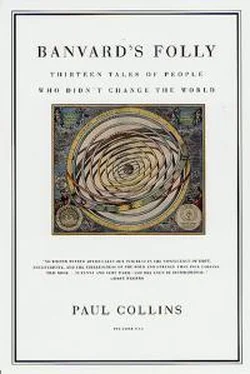... George Psalmanazar.
"We have an annual sacrifice of children on the island," he told one assemblage. "Eighteen thousand eight-year-old boys are sacrificed at the altar."
The group gasped, appalled.
"But surely," someone would point out, "Formosa's population cannot support such an annual massacre?"
George shrugged.
"Our god demands it."
On no point could he be made to retract or alter his claims. Ever. It was, he later revealed, a deliberate strategy:
There was one maxim I could never be prevailed upon to depart from, viz. that whatever I had once affirmed in conversation, tho' to ever so few people, and tho' ever so improbable, or even absurd, should never be amended or contradicted in the narrative. Thus having once, inadvertently in conversation, made the yearly number of sacrificed infants to amount to eighteen thousand, I could never be persuaded to lessen it, though I had been often made sensible of the impossibility of so small an island losing so many inhabitants every year, without becoming at length quite depopulated, supposing the inhabitants to have been so stupid as to comply.
George's many friends and defenders, irate at the whispers of fraud,
published ads daring anyone to prove such an assertion--even offering cash if they could do it. No one appears to have taken them up on the offer. But perhaps it was only a matter of time.
Two months had already passed since George and Innes had arrived. Innes, sensing that a counterattack was needed, had already goaded George into producing yet another document in Formosan--a rendering of the catechism. But now the bishop and his other allies wanted more, Chaplain Innes told George.
They wanted the entire history of the island. George didn't know the faintest thing about Formosa. "You have two months," Innes said.
Strange to reflect, but it was easier three hundred years ago to get a book published quickly than it is today; Psalmanazar's book was finished in March and in London bookstalls by mid-April. Scarcely three months had passed since Innes had suggested the project.
Psalmanazar may have been an indifferent student and an unprincipled fraud, but he was also a maniacally driven writer. In February and March of 1704, in the moments he could squeeze away from the tables of local nobles and clergy, he worked frantically on his manuscript. At his side sat a copy of Varneius's 1646 history Descriptio Regni Japoniae et Siam, from which he freely stole, and which, just to be contrary, he pointedly contradicted. As fast as Psalmanazar could produce the pages, his Latin manuscript was "Englished" by Oswald, his translator. In the space of two months, Psalmanazar produced a 288-page book and sketched out dozens of plates and illustrations. The result, An Historical and Geographical Description of Formosa, might have the most insolently ironic opening sentence in English literature: "The Europeans have such obscure and various Notions of Japan, and especially of our Island Formosa, that they can believe nothing for Truth that has been said of it."
Psalmanazar did more than create a dreary recounting of royal lineages and politicians; he conjured an entire world. Writing over a century later, the antiquarian Isaac D'israeli was still so flabbergasted by the book's audacity that he was reduced to sputtering:
If the reader is curious to examine this extraordinary imposture, I refer him to that literary curiosity, "An historical and geographical Description of Formosa ... by George Psalmanazar, a Native of the said Isle," 1704; with numerous plates, wretched inventions! of their dress! religious ceremonies!
their tabernacle and altars to the sun, the moon, and the ten stars! their architecture! the viceroy's castle! a temple! a city house! a countryman's house! and the Formosan alphabet!
Not content with that, Psalmanazar also included interlinear translations from Formosan to English of the Lord's Prayer and the Ten Commandments, buttressed by fold-out plates of the Formosan language and a chart of the Formosan numerical system. These he followed with botany, zoology, gastronomy-both plants and human body parts were eaten raw --and an account of the island's history replete with conquests, emperors, and daggered intrigue.
He even reproduced a letter from the King of Japan to the King of Formosa, though where exactly George could have got such a document nobody seems to have thought to ask. But such errors are easy to find. Psalmanazar had also included a detailed accounting of the island's mineral resources, which apparently included two brass mines--a sight that any metallurgist would certainly be most interested in seeing.
The most sensational part of the book related to the island's religious practices. Psalmanazar conjured up two founding fathers of the Formosan religion, the philosophers Zeroaboabel and Chorhe Mathcin:
They Demonstrated, by many Arguments, that there is one Supreme God, who is above all the visible things in the World .... But if they would Worship him according to his mind, in an acceptable manner, they should Build him a Temple, and in that they should make a Tabernacle, and an Altar, and upon the Altar they should Burn 20000 Hearts of young Children, under 9 Years of Age.
Not surprisingly, the Formosans drove out the two bloodthirsty prophets, at which point a pestilence descended upon the land; it was alleviated only when, in a slight concession to parental anger, God reduced His divine quota a little and let girls off the hook:
Ye shall begin the Year from this day, which is the first day of the Month Dig, and the first of the Festival of 10 days, and at this Festival ye shall Sacrifice to me every Year the hearts of 18000 young boys, under the age of 9
Years .... every month ye shall Sacrifice in all your Temples 1000 Beasts, viz. 300 Bulls, 400 Sheep or Rams, and the rest in Calves or Lambs.
This annual loss of children, Psalmanazar claimed, was more than made up for by the institution of polygamy on the island. And even with the occasional mass roasting of children's hearts, George was quick to assure his readers that Formosa remained "one of the most Pleasant and Excellent of all the Asiatick Isles."
Some critics, however, were unimpressed. It wasn't Psalmanazar's bizarre description of Formosa that caused problems. It was that he had tacked a rather conventional theological treatise onto the second half of the book.
Critics were suspicious of how a recent immigrant from Formosa could knock out an abstruse hundred-page essay on Christianity--and he a nineteen-year-old.
Worried by these complaints, Chaplain Innes began to quietly bump up George's age in conversations. Psalmanazar was, he now claimed, actually twenty-two years old.
But the objections of critics hardly mattered, at least at first. London booksellers, clamoring for months for Psalmanazar's book, could barely keep copies in stock; Innes pressed him to write an expanded second edition, even as the first was being translated and rushed into print in French, German, and Dutch editions. And soon Psalmanazar received word that Bishop Compton, his new mentor, had arranged for him to spend a semester attending his old alma mater--Christ Church College, at Oxford University.
When you walk into Christ Church, you have arrived.
In the early morning, there is a mist on the quad, through which you can see the carved statue of Mercury; beyond that, there is the towering spire of the cathedral, and the looming stone and wood of the quiet dormitories. Then there is the great Meadow, on which scarcely a moving form can be seen at such an early hour.
It is the focal point of an empire: that space in which the most promising minds are concentrated for a brief moment in their lives, before being refracted outward across the spectrum of British society. Sir Christopher Wren built the college cathedral not long before Psalmanazar's arrival, and John Locke had prayed in it as a student; a century hence, Lewis Carroll would be crossing the college quad with his math students. This, the most imposing college of the empire's greatest university, was where Bishop Compton had sent George Psalmanazar, alleged Formosan and actual theology dropout.
Читать дальше











